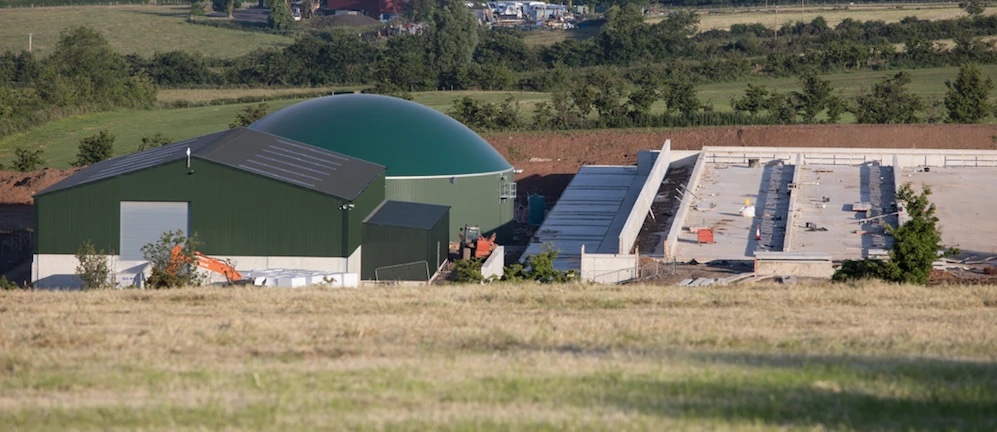Documents obtained by SourceMaterial show how a tiny tweak in a ministry submission to Brussels unlocked hundreds of millions in subsidies
Northern Ireland’s spending watchdog has urged First Minister Arlene Foster’s government to look again at an expensive and environmentally damaging subsidy for electricity produced from biogas.
The Northern Ireland Audit Office’s report was prompted in part by our 2018 Muck for Brass
investigation, which showed how an £800 million green energy scheme was hijacked to fuel a huge expansion of intensive farming—with ordinary households across the UK footing the bill.
Now SourceMaterial is publishing for the first time documents that show how in 2011 officials in the Department for Enterprise Trade and Investment, then run by Foster, used dodgy numbers to justify the lucrative subsidies.
The decision to raise the subsidies for anaerobic digesters, which burn biogas made from
waste material to generate electricity, led to owners of plants in Northern Ireland being able to claim up to four times as much money as operators in the rest of the UK.
It was a vital boost for the province’s poultry industry, whose expansion had been hampered by restrictions on the amount of chicken litter they could produce. Turning the waste to biogas solved the problem and spurred construction of polluting ‘mega-farms’ across the region.
Biogas subsidies were part of a wider scheme called the Northern Ireland Renewables Obligation (Niro), which the NI Audit Office said is on track to cost £5 billion, with the vast majority being paid for by energy users in England, Scotland and Wales.

“We identified a significant risk that some investors may be achieving a higher financial return
than was required to encourage adoption of the various supported technologies”, the Audit Office
said. “We also identified that the speed of uptake, (particularly in the two years leading up to the closure of the NIRO) has created significant additional environmental and planning impacts.”
The story begins in 2010 when, as enterprise minister, Foster issued a call for evidence to enable the introduction of more generous biogas subsidies. The figures would then be used to build a case for state aid that could be taken to Brussels for approval from the European Commission.
In response the Department of Enterprise Trade and Investment received 20 submissions which were in effect feasibility studies from people interested in building anaerobic digestion plants. The documents were obtained by SourceMaterial through freedom of information requests.
As the Audit Office noted, Foster was asking for evidence from developers with a vested interest.
But for the department, which was subject to heavy pressure form Northern Ireland’s powerful agribusiness lobby, even that appears to have been insufficient to get the answer they wanted.
The Niro scheme, like many environmental subsidies, assumes that smaller-scale technologies require greater payments to make them viable. For anaerobic digesters the key threshold was 500 kilowatts.
Generating stations with capacity equal to this or lower would each receive four subsidy payments in the form of renewable obligation certificates, or Rocs, for every megawatt hour of electricity produced, compared with just three certificates for larger plants.
But close examination of the documents shows that in making the case to subsidise 500kW generating stations with an unprecedented four certificates, Foster’s officials relied entirely on cost estimates for much smaller 360kW plants, which need a larger subsidy to be viable because they are less efficient.
The documents show that even by the departments’s own maths, the 500kW stations only needed three certificates to make a 12.5 per cent return, already in excess of the 10 per cent profit used for calculations elsewhere in the UK.
By the time the application landed on officials’ desks in Brussels, the key document stated incorrectly that the calculation for four certificates was on the basis of generating stations “less than or equal to” 500kW. In fact, the underlying spreadsheet shows the opposite was the case: the 500kW to 5,000kW band began at “greater than or equal to 500kW”.
This seemingly tiny discrepancy made an enormous difference in practice because the developers naturally tend to opt for the largest generating station they can in a given subsidy band. Around two thirds of Northern Irish biogas plants are of the 500kW and the tweak that shifted them into a higher bracket unleashed a torrent of hundreds of milions of pounds in subsidies, all funded by extra charges on UK rate payers’ bills.
When asked whether this error was the result of a deliberate attempt by officials or ministers to rig the submission to bolster the case for a higher subsidies, a spokesman for the department, now renamed the Department for the Economy, said: “As has been noted, 500kW stations were not included in the lower band when the 2010 analysis was conducted.
“However, the Department can confirm that re-running the analysis to include 500kW stations in the lower band would not change the outcome (i.e. the result would still be 4 Rocs, based on the information available) and, accordingly, the motivation that you have attributed to the Department is unjustified. The rationale that was provided at the time still stands.”
Picture: Sandy Watt for SourceMaterial

